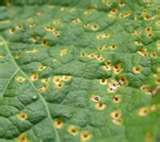|
 Hollyhock rust, evergreen pruning, to-do list Hollyhock rust, evergreen pruning, to-do list
By John
Fulton
 Send a link to a friend
Send a link to a friend
[July 07, 2012]
Hollyhocks are one of the traditional,
old-fashioned flowers often grown in our area. This year, they are
definitely interesting. Even before the flowers open. Most area
hollyhocks are again infected with rust. Rust is usually a spring
and fall disease problem, when it occurs. This year it has been
ferocious.
|
 Rust first shows up on the bottom of the lower leaves, and then
some rather striking bright yellow to orange spots develop on
the top side of the leaves. Rust can attack all plant parts,
including leaves, stems and leaf petioles. Rust first shows up on the bottom of the lower leaves, and then
some rather striking bright yellow to orange spots develop on
the top side of the leaves. Rust can attack all plant parts,
including leaves, stems and leaf petioles.The rust disease
spends the winter in old plant parts on the ground. Removal of
the plant material will help reduce infection possibilities, so
remove dried, infected leaves now. Increasing air flow and
reducing humidity will also help. Control is best accomplished
by removing infected leaves at the first sign of the rust (on
the bottom of the leaves). Chemical control may be needed, and
sprays containing sulfur are effective.
Pruning evergreens
This is the time of year to wrap up pruning chores on
evergreens. This includes both needle-type and broadleaf
evergreens. If you're wondering what a broadleaf evergreen is,
that includes holly, rhododendron and azalea. The logic behind
pruning your yews at this time is to allow sufficient time for
regrowth to become hardened off before winter and to keep new
growth from becoming too rank before the winter months.

Pruning evergreens is part art and part science, but mostly
art. A few simple rules to follow make the job results much more
pleasing. Upright-growing evergreens, such as pines and spruces,
should not have the main leader cut off. This will destroy the
natural shape and will make the resulting growth more
susceptible to breaking off. If individual branches are being
cut off, they should be cut back to a bud. This will allow the
bud to become the new main branch. You can also control growth
direction of branches in this way. If you are growing trees for
cut Christmas trees, all bets are off, as you are only dealing
with trees through the first seven years or so of their life.
Make sure you use the proper equipment. Individual pruning
cuts are best done with bypass loppers or pruning shears. These
make clean cuts without much damage to the remaining wood. The
old anvil-type shears and loppers cut to a point, then crush the
remaining wood. For yews, junipers and arborvitae that are
trained to a certain size or shape, you will want to use hedge
shears (electric or manual) that are sharp and properly
tightened. Most of these types of shears can cut up to about a
quarter of an inch in size.
[to top of second column] |

When pruning evergreens, remember the dead zone. This is the area
toward the center of the plant that doesn't receive much light. It
also has few needles or active buds. Cutting into the dead zone will
cause many years (or forever) of little green growth. Also remember
to prune so that the base of plants is wider than the top. This
allows sunlight to hit the bottom area as well, and keeps plants
from browning from the bottom up.
To-do list
-
Keep up with, or
start, foundation sprays. The common products are permethrin or
bifenthrin. Apply them to the foundation and adjacent foot of
soil, flowers, etc. This will put down a barrier for insects
such as ants and crickets.
-
Keep a good spray
or dust program going on your cucumbers, pumpkins, squash and
melons. This will help control vine borers and beetles that
carry the wilt virus.
-
Check tomatoes for the fungal diseases
such as Septoria. If spots are on the leaves, you will need to
apply a fungicide to halt the progress. Fungicides available
include chloranthanil and maneb. Also, check for leathery
bottoms on tomatoes. This would be blossom-end rot, caused by a
calcium imbalance in the plant. Mulching will help even out
moisture flow, and addition of calcium through foliar
fertilizers may help, but control will be a challenge in a
drought year.
[By
JOHN FULTON,
University of Illinois Extension]
 |